
Concept explainers
a.
To write a formula V(x) for the volume of box.
a.
Answer to Problem 51RE
The required formula is
Explanation of Solution
Given information: A piece of cardboard measures 10 in. by 15 in. Two equal sides are removed from the corners of a 15 in. sides.
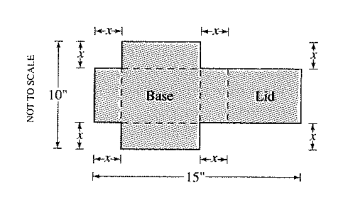
Calculation: The required formula is obtained as,
Refer to the diagram exercise 18 of the sction 4.4, but imagine the vertical side as 15” and the horizontal side as 10” .
The length of box be
The width of box be
The height of box be
Hence, the required formula is
b.
To find the domain of V for the problem situation and graph V over this domain.
b.
Answer to Problem 51RE
The domain is: 0 <
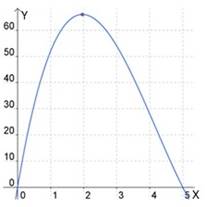
Explanation of Solution
Given information: A piece of cardboard measures 10 in. by 15 in. Two equal sides are removed from the corners of a 15 in. sides.
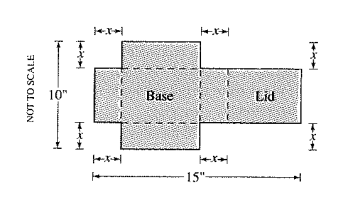
Calculation: The required solution is obtained as,
Hence, the domain is: 0 <
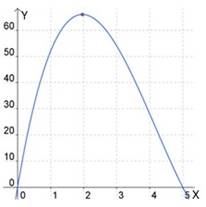
c.
To find the maximum volume and the value of x that gives it, by using a graphical method.
c.
Answer to Problem 51RE
The maximum is at approximately
Explanation of Solution
Given information: A piece of cardboard measures 10 in. by 15 in. Two equal sides are removed from the corners of a 15 in. sides.
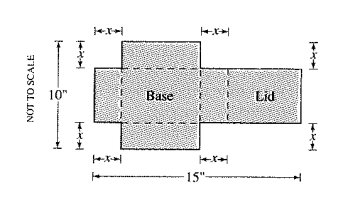
Calculation: The required solution is obtained as,
From the graph, the maximum is at approximately
d.
To confirm your result in part (C) analytically.
d.
Answer to Problem 51RE
The required solution is 1.96.
Explanation of Solution
Given information: A piece of cardboard measures 10 in. by 15 in. Two equal sides are removed from the corners of a 15 in. sides.
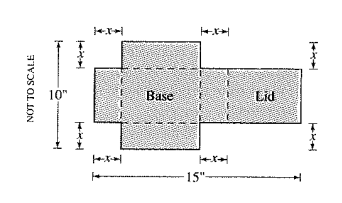
Calculation: The required solution is obtained as,
Find V’ and where it is = 0.
Hence the required solution is 1.96.
Chapter 5 Solutions
Calculus 2012 Student Edition (by Finney/Demana/Waits/Kennedy)
Additional Math Textbook Solutions
Basic Business Statistics, Student Value Edition
A Problem Solving Approach To Mathematics For Elementary School Teachers (13th Edition)
College Algebra with Modeling & Visualization (5th Edition)
Calculus: Early Transcendentals (2nd Edition)
Pre-Algebra Student Edition
 Calculus: Early TranscendentalsCalculusISBN:9781285741550Author:James StewartPublisher:Cengage Learning
Calculus: Early TranscendentalsCalculusISBN:9781285741550Author:James StewartPublisher:Cengage Learning Thomas' Calculus (14th Edition)CalculusISBN:9780134438986Author:Joel R. Hass, Christopher E. Heil, Maurice D. WeirPublisher:PEARSON
Thomas' Calculus (14th Edition)CalculusISBN:9780134438986Author:Joel R. Hass, Christopher E. Heil, Maurice D. WeirPublisher:PEARSON Calculus: Early Transcendentals (3rd Edition)CalculusISBN:9780134763644Author:William L. Briggs, Lyle Cochran, Bernard Gillett, Eric SchulzPublisher:PEARSON
Calculus: Early Transcendentals (3rd Edition)CalculusISBN:9780134763644Author:William L. Briggs, Lyle Cochran, Bernard Gillett, Eric SchulzPublisher:PEARSON Calculus: Early TranscendentalsCalculusISBN:9781319050740Author:Jon Rogawski, Colin Adams, Robert FranzosaPublisher:W. H. Freeman
Calculus: Early TranscendentalsCalculusISBN:9781319050740Author:Jon Rogawski, Colin Adams, Robert FranzosaPublisher:W. H. Freeman
 Calculus: Early Transcendental FunctionsCalculusISBN:9781337552516Author:Ron Larson, Bruce H. EdwardsPublisher:Cengage Learning
Calculus: Early Transcendental FunctionsCalculusISBN:9781337552516Author:Ron Larson, Bruce H. EdwardsPublisher:Cengage Learning





